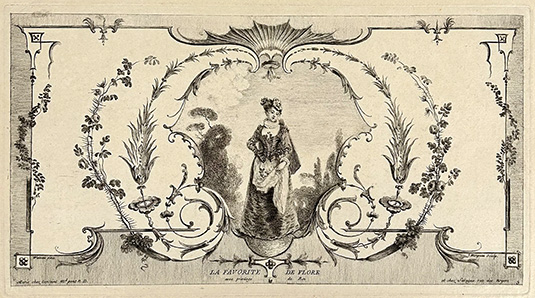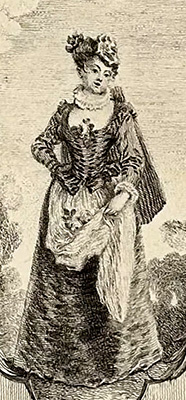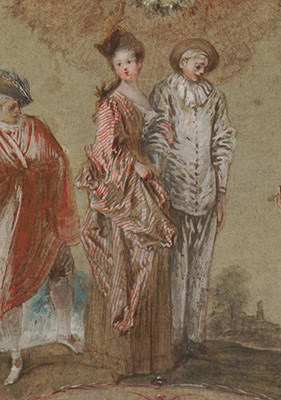
- Home Page
- Accepted
Paintings & Copies - Doubtful
Attributions - Doubtful Textual References
- Alternative
Titles - Collectors &
Museums - Bibliography
- Search Abecedario
- Watteau &
His Circle
La Favorite de Flore
Entered October 2025

Presumed lost
Materials unknown
Measurements unknown
RELATED PRINTS

Jean Moyreau after Watteau, La Favorite de Flore, engraving, c. 1729.
This decorative composition was engraved by Jean Moyreau and was announced for sale in the April 1729 issue of the Mercure de France (p. 750). The caption of the engraving states “Watteau pinxit,” the "pinxit" assuring us that the print was made from a painted arabesque and not just a preparatory drawing. Mariette in his Notes described Favorite de Flore and Heureux moment as “compositions d’ornements propres pour des dessus de portes” [compositions for overdoor paintings].
La Favorite de Flore and its pendant, Le Marchand d’orviétan, also engraved by Moyreau, were part of a suite of four decorative designs. The other two, Le Berger content and L’Heureux moment, were engraved by Louis Crépy fils. Those figures are set to a different scale and the decorative surrounds are unrelated to those here. In other words, the two sets of arabesques are visually unrelated.
PROVENANCE
Paris, with Edme François Gersaint (1694-1750; dealer in paintings and luxury goods), according to the Mercure de France, April 1729 (p. 750): “Le Sieur Gersaint voyant que les Curieux recevoient favorablement les morceaux d'ornemens qu'il a fait graver, d'après les Tableaux & Desseins originaux faits par VATTEAU, a été encouragé de faire continuer les autres ouvrages du même Auteur qu'il avoit entre les mains (. . . ).” The latter phrase implies that Gersaint owned the painting.
SELECT BIBLIOGRAPHY
Mariette, “Notes manuscrites,” 9: fol. 198.
Goncourt, L’Art au XVIIIème siècle (1860), 59.
Goncourt, Catalogue raisonné (1875), 221, cat. 302.
Josz, Watteau (1904), 32.
Deshairs, “Les Arabesques de Watteau” (1913), 294.
Dacier, Vuaflart, and Hérold, Jean de Jullienne et les graveurs (1921-29), 2: 28, 58, 133; 3: cat. 9.
Rahir, Watteau, peintre d’arabesques (1922), cat. 65.
Réau, “Watteau” (1928), cat. 276.
Adhémar, Watteau (1950), cat. 29.
Macchia and Montagni, L’opera completa di Watteau (1968), cat. 39C.
Cailleux, “Un Étrange monument” (1975), 249.
Roland Michel, Watteau (1981), cat. 70.
Glorieux, À l'Enseigne de Gersaint (2002), 190, 194, 205.
Glorieux, “Tableaux remarquables” (2006), 79.
Michel, Le “célèbre Watteau” (2008), 184.
RELATED DRAWINGS
No Watteau drawings can be directly associated with La Favorite de Flore.
REMARKS

Jean Moyreau after Watteau, La Favorite de Flore (detail).

Watteau, La Coquette (detail), gouache and watercolor on paper. London, British Museum.
As is to be expected, there is disagreement among scholars who have considered the date of La Favorite de Flore, although there is consensus that it figures early in the artist’s career. Adhémar placed it c. 1708-09, while Macchia and Montagni preferred c. 1709. An interesting clue to the date of this work is the resemblance between “Flore” and the actress in a fan design, La Coquette (Rosenberg and Prat 189). The actress in the latter work, generally dated c. 1712-13, is closely related in terms of her tall, thin proportions and the stiffness of her carriage.
The painted medium of the fan suggests something of the color of the Watteau arabesques, as opposed to the black, linear transcriptions of the engraved arabesques.